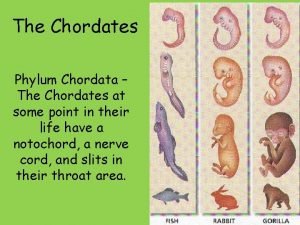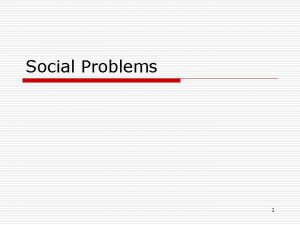Cancer Chapter 11 Defining Cancer Cancer represents a












- Slides: 12

Cancer Chapter 11

Defining Cancer • “Cancer” represents a number of diseases • Definition: A collection of cells that reproduce in an uncontrolled way to produce a mass of cells • Causes: Chemical Agents; Biological Agents; Environmental Factors; Genetic Factors; Individual Behaviors

Tumors • • Cell mass=tumor (two types) Benign tumor (may grow in size, but do not reproduce or spread) Malignant tumor (life threatening) Tumors in action Metastasize (spread)

Categories of Cancer • Categorized based on cellular typology 1) Carcinomas- epithelial cells found in skin, glands, or organs 2) Sarcomas- soft tissues including fat, muscle, nerves, or tendons 3) Leukemia- blood producing tissue, e. g. , bone marrow 4) Lymphomas- glandular (lymphatic system); organs producing white blood cells

Examples of Cancer Categories Type Examples Outcome Other Carcinomas Skin, breast, liver, bladder, and prostate Likely to be fatal (with the exception of skin cancer); the most common type is not always the deadliest >50% of new cancer cases every year are skin cancer Sarcomas Kaposi’s sarcoma Typically malignant; often metastasize Genetic as well as chemical and viral causes Leukemia, Childhood leukemia Very high mortality rate 70% of people in need of bone marrow transplant cannot find match; within families 40% of White/2% of Blacks find sibling matches Lymphomas Hodgkin's lymphoma, Non. Hodgkin’s lymphoma Non-Hodgkin’s fatal; Hodgkin’s less severe, less likely to metastasize Affects T and B white blood cells; become malformed and malfunction

Cancer: Gender Differences • • • Is cancer a women’s disease? Men have higher risks (behaviorally and otherwise) Most common among U. S. men: prostate, lung, and colorectal Most common among U. S. women: breast, lung, and colorectal # of female smokers continues to grow Cancer is not the leading cause of death for men or women in the U. S.

Cancer: Genetic Risk Genetics: Let’s recall what genes can tell us about a person? • Ancestral geography OR paternal/familial information • BRCA 1 and BRCA 2 when mutated, have been linked to breast cancer • This speaks to geography—Ashkenazi Jewish women and groups of English/Icelandic women • Originally 18%-20% of all breast cancer occurred within Ashkenazi population • Ashkenazi women have an 82% risk for developing breast cancer over their entire lifetime (this includes an increase in risk with age) • Lynch syndrome (an inherited disease) has been linked to colorectal cancers • This speaks to familial (or generational) transmission • 1 st, 2 nd, and 3 rd degree relatives increases the likelihood (relative risk) for developing colorectal cancer

Cancer: Racial Differences • Greater incidence of breast cancer in White U. S. women than in other racial groups • Greater incidence of death due to breast cancer in Black and Latina women • Why? • Access to care/insurance as it correlates to race in U. S. • Socioeconomic class as it correlates to race in U. S. Unfortunately, these findings hold for all cancers, not just breast cancer

Cancer: Risk Factors • Environmental (Carcinogens) • Behavioral • Pesticides • Smoking • Air pollution • Diet • Nuclear waste • Exercise • Asbestos • Obesity • Cell phones (? ) • STDs

Prevention and Early Detection is EVERYTHING • Diet and Exercise: Fast food culture and colon cancer • Breast self-examination • Vaccinations

The Diagnosis: What happens next? • Next week we will cover more about receiving a cancer diagnosis • Psychologically • Comorbidity: depression, anxiety, fear • Patient-provider relations • Medical treatment • Removal of mass/tumor • Chemotherapy

Psychotherapeutic Approaches • • Ms. Nobel will provide us with more detail next week! Cognitive behavioral therapy Educational intervention Bibliotherapy Supportive-Expressive therapy (meaning-making) Complementary/Alternative therapies (CAM) Coping strategies (emotion focused comping can leave you being more focused on your symptoms) • Sprituality • Social-emotional support: face to face or online • Interpersonal relationships and advocacy
 Non defining relative clause
Non defining relative clause Relative clauses defining and non defining
Relative clauses defining and non defining Defining and non defining relative clauses
Defining and non defining relative clauses Defining relative clause meaning in telugu
Defining relative clause meaning in telugu Relative clauses
Relative clauses Finite relative clause
Finite relative clause What does intelligence mean
What does intelligence mean The defining moment in greek history is the wars.
The defining moment in greek history is the wars. Alligator phylum and symmetry
Alligator phylum and symmetry Social issues definition
Social issues definition Romeo and juliet act 4 summary
Romeo and juliet act 4 summary Lady montague defining quotes
Lady montague defining quotes Nondefining relative clause
Nondefining relative clause























